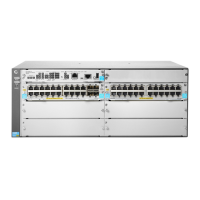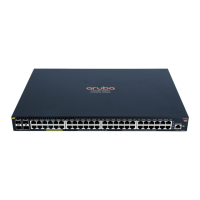122
• VRRP group 3—Router C is the master. Router A and Router B are the backups.
To implement load sharing among Router A, Router B, and Router C, perform the following tasks:
• Configure the virtual IP addresses of VRRP group 1, 2, and 3 as default gateway IP addresses
for hosts on the subnet.
• Assign the highest priority to Router A, B, and C in VRRP group 1, 2, and 3, respectively.
VRRP load balancing mode
In a standard-mode VRRP group, only the master can forward packets and backups are in listening
state. You can create multiple VRRP groups to share traffic, but you must configure different
gateways for hosts on the subnet.
In load balancing mode, a VRRP group maps its virtual IP address to multiple virtual MAC addresses,
assigning one virtual MAC address to each member router. Every router in this VRRP group can
forward traffic and respond to IPv4 ARP requests or IPv6 ND requests from hosts. Because their
virtual MAC addresses are different, traffic from hosts is distributed across the VRRP group
members. Load balancing mode simplifies configuration and improves forwarding efficiency.
VRRP load balancing mode uses the same master election, preemption, and tracking mechanisms
as the standard mode, and adds new mechanisms as described in the following sections.
Virtual MAC address assignment
In load balancing mode, the master assigns virtual MAC addresses to routers in the VRRP group and
uses different MAC addresses to respond to ARP requests or ND requests from different hosts. The
backup routers, however, do not answer ARP requests or ND requests from hosts.
In an IPv4 network, a load balanced VRRP group works as follows:
1. The master assigns virtual MAC addresses to all member routers, including itself. This example
assumes that the virtual IP address of the VRRP group is 10.1.1.1/24, Router A is the master,
and Router B is the backup. Router A assigns 000f-e2ff-0011 for itself and 000f-e2ff-0012 for
Router B. See Figure 33.
Figure 33
Virtual MAC address assignment
Gateway IP: 10.1.1.1/24 Gateway IP: 10.1.1.1/24
Virtual MAC: 000f-e2ff-0012
Virtual IP address:10.1.1.1/24
Host A Host B
Router A
Master
Router B
Backup
Network
Virtual MAC: 000f-e2ff-0011
Virtual IP address:10.1.1.1/24
Allocate Virtual MAC
000f-e2ff-0012 to Router B

